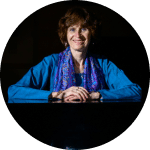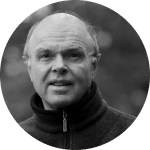

This solo arose from trials that focused on kinds of sensing, co-ordinations and shapings. There was a long series of rehearsals of improvisation through which I attempted to define a movement world – from where did it arise in the body, with what kind of attributes, expressing what? This process had a measure of dance satisfaction for me however it led in too many directions to suggest a singular choreographic world. Out of curiosity and necessity I studied many studio trials in one long viewing session. I asked myself – what is trying to come through this varied material. The watching was an interesting exercise in trust and patience as I tried to establish a neutral gaze, to see what was there, and what was returning in multiple forms. I was able to progress and begin to shape the piece once I saw three states or identities: the quadruped, the biped, and the winged beings.
These three studio trials show some explorations in the allegro of the winged section. The first studio trial shows something that I just had to allow: a loosely improvised flailing driven by the music. Not for public consumption but still, an essential messy step. This is what Allan Bell would call getting passed one’s banalities. The second two trials show a developing vocabulary and musical complementarity. The challenge was to stay connected to the essence of the creature while avoiding a clichéd mimesis. Recognizing that animal dances connect us outward to all that is, I was strongly motivated to find a choreographic and expressive solution.
I began this work with free improvisations, trying to find my way into a vocabulary world. For this purpose, I revisited two pieces of music that had been part of the SWW inquiry from the beginning: Le Regard de L’Enfant Jésus, Olivier Messiaen, Dénouement, Alexina Louie, and then also Glenn Gould’s interpretations of Bach’s Goldberg Variations. Each of these works possess a saturated beauty, and I had to ask how dance might complement this beauty. In each case I found it impossible to get past the completeness of the music, impossible to find a dance world while also allowing this music into the studio trials. It was a movement breakthrough and a conversation with SWW Musical Advisor Allan Bell that sent me to my ultimate choice, three selections from Giacinto Scelsi’s 4 Pezzi Su Una Nota Sola. Rather than saturated beauty, Scelsi’s pieces each offered profound explorations of a single note through rhythm, dynamics and timbre.
I felt that this musical focus supported the three distinct vocabularies that finally surfaced as the movement subjects of the work.
In SWW 18, the choreographer chose a music composition/score that included three distinct sections, allowing her to explore and develop three distinct movement sections. The quadruped, the biped and the winged became the choreographic themes worked on, with the overarching theme of the animal world. I came in as the rehearsal director, with these sections already sketched out and taking shape. My role was clear, to help bring forward the unique qualities of each theme and support the choreographer /performer in finding seamless transitions between sections. I will use the quadruped as an illustration. We realized that careful consideration of body position helped to draw out the animal form. Particular angles, facings, and directions revealed more asymmetrical and 3-dimensional interest in the body and movement vocabulary. The physicality of the quadruped meant mostly working low to the ground. The choreographer/ performer moved in deep hip flexion with locomoting lunges and off-centre pliés. With fists reaching and hitting the ground, I noted that the added layer of oppositional push and pulls from the upper body (such as flexion, extension and undulations of the spine), when emphasized, helped to deepen the animal expression.
Helen Husak
In our first conversations about the piece discussing the music and the general evolution of the choreography as it was developing the idea of something fairly neutral and form suggesting was the starting base. Since the piece was travelling over changes there was something interesting in keeping the garment living in a space of rawness and tones that complimented that. In going with a jumpsuit we wanted to keep the arms the most tight since a lot of the movements had a focus on this area, but not have them distract from the overall cohesive feeling. Going with a raw silk leaned into this idea of rawness, earthiness but still having a feeling of flow and in an act to create more texture, playing on the pitch idea of the music, iron staining was added giving the garment a hint more life itself amid the choreography.
Costume Notes Hannah Fisher
This one was easy, just make Davida and the costume look good, provide some dimension and sense of being in an open field, and make sure nothing overexposes in the camera.
Steve Isom
Lighting Designer



III
0 – single voice violin
5 – second voice enter and fade
11- second voice
to 45 – Build in wowing
47 – 1’02 – siren oscillation and resolve
1’09 – 1’22 – French Horns
1’24 – 1’37 – 1’47 – sense of acceleration and 2 crescendos – Trumpets
1’54 – 2’21 thinning and
2’21 – 2’43 single voice diminishment to pianissimo
2’44 – 3’03 two-part pulsing section
3’02 – pluck
3’07 – darker sounds
3’09 – 3’39 complex shaded drone sound A
3’40 – 3’48 high layer soft drone sound B
3’49 – 4’03 sound A continues with far away
4’06 – 4’24 mid drone C single voice violin
I
4’29 – numerous voices together, short crescendo diminuendos
4’47 – horn change introduces fuller sound
4’57 – sliding singles and group
5’12 – 5’24 five short crescendos w tamtam
5’24 – 5’34 soft sustain
5’33 – 5’38 – 5’42 three hollow knocks
5’44 – 5’57 short ensemble build
5’59 – 6’15 single oboe w violin
6’17 – 6’34 bumble bee crescendo + breath
6’37 – 6’38 bumble bee crash + breath
6’39 – 6’51 – low soft sustain
6’52 – 6’58 – sighing arpeggio strings
6’59 – 7’03 darker louder shorter
7’05 – 7’17 single voice viola
IV
7’18 – single voice then slowly thickening w horns fading and again
7’39 – nudging horns
7’49 – ensemble thickening building releasing
8’07 – feeling of resolve and build
8’16 – chord pulses in waves of dynamic build x4 w trumpets
8’35 – timpani, strong build w horns and strings
8’54 – 9’01 simmer
9’02 – strong builds, crashes w horns timpani wood blocks dark and strong
9’20 – violins sustain
9’31 – violins quick pulse w wood block knocks
9’40 – trumpets enter full dark loud crashing
10’26 – release begins
10’35 – release arrival w horns
10’41 – float horns w pulse
10’49 – float continues new voice
10’54 – dark sound joins diminishing float
11’00 – new horn dominates
11’06 – five horn pulses
11’12 – oboe enters slide
11’18 – five pulses slower, holding last pulse
11’34 – 11’48 last single violin or viola